Hotel's Room Revenue Management Strategy and Performance Analysis
VerifiedAdded on 2022/12/05
|7
|1379
|452
Report
AI Summary
This report examines a hotel's room revenue management strategy, focusing on the business climate, proposed pricing policies, and distribution channel strategies. The analysis begins with a review of the business climate, including infrastructure, business environment, service sectors, and industrial base, justifying the hotel chain and category for a new location. It then delves into market segmentation, including demographic, geographic, psychographic, and behavioral approaches. The report explores the hotel's proposed room pricing policy, considering needs-based segmentation such as problem-solving, emotional, functional, and value alignment. Finally, it outlines the hotel's proposed distribution channel strategy, emphasizing website optimization, SEO, differentiation, and collaborations with online travel agencies. The report concludes with a summary of the key findings and recommendations for effective revenue management.
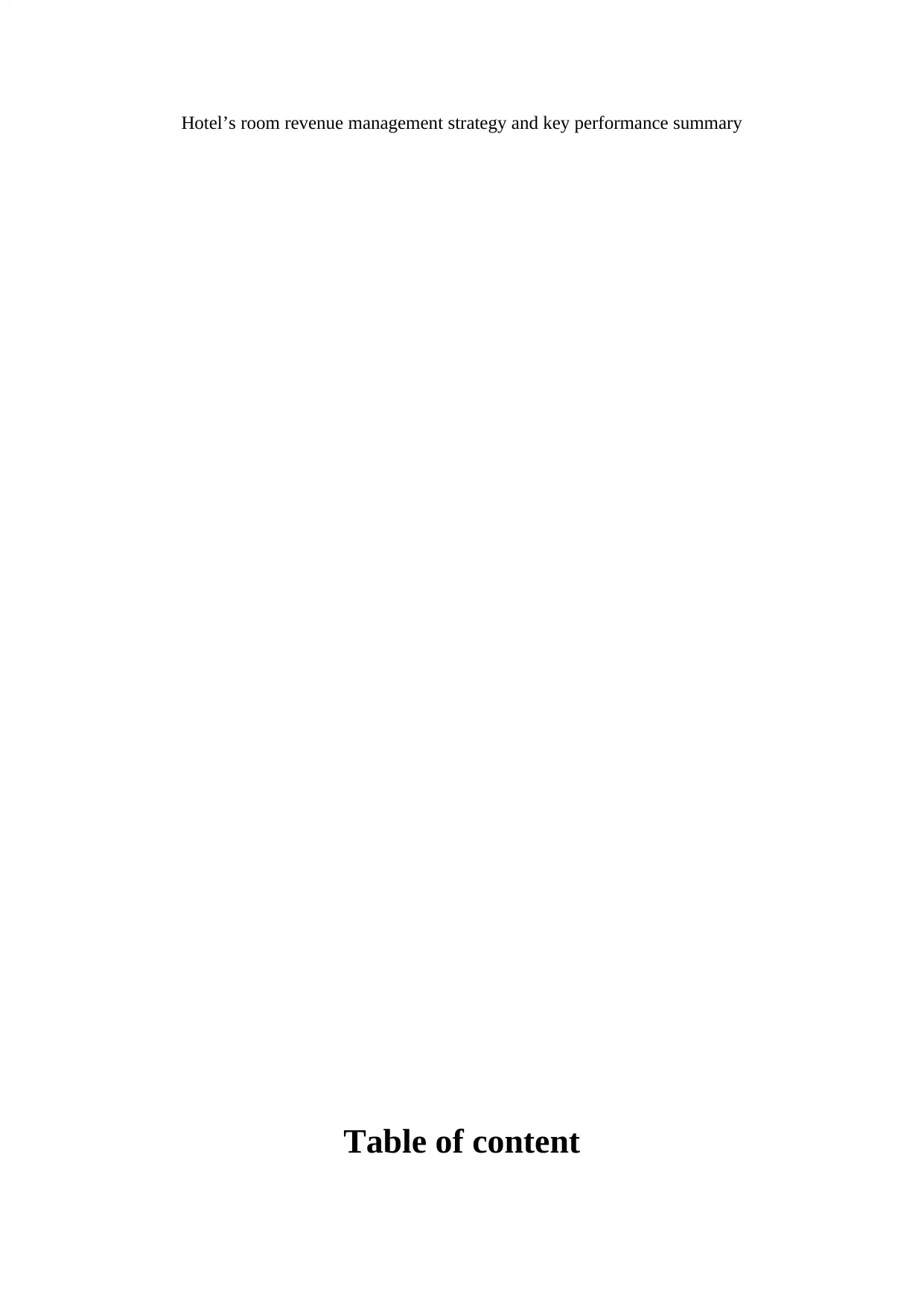
Hotel’s room revenue management strategy and key performance summary
Table of content
Table of content
Paraphrase This Document
Need a fresh take? Get an instant paraphrase of this document with our AI Paraphraser
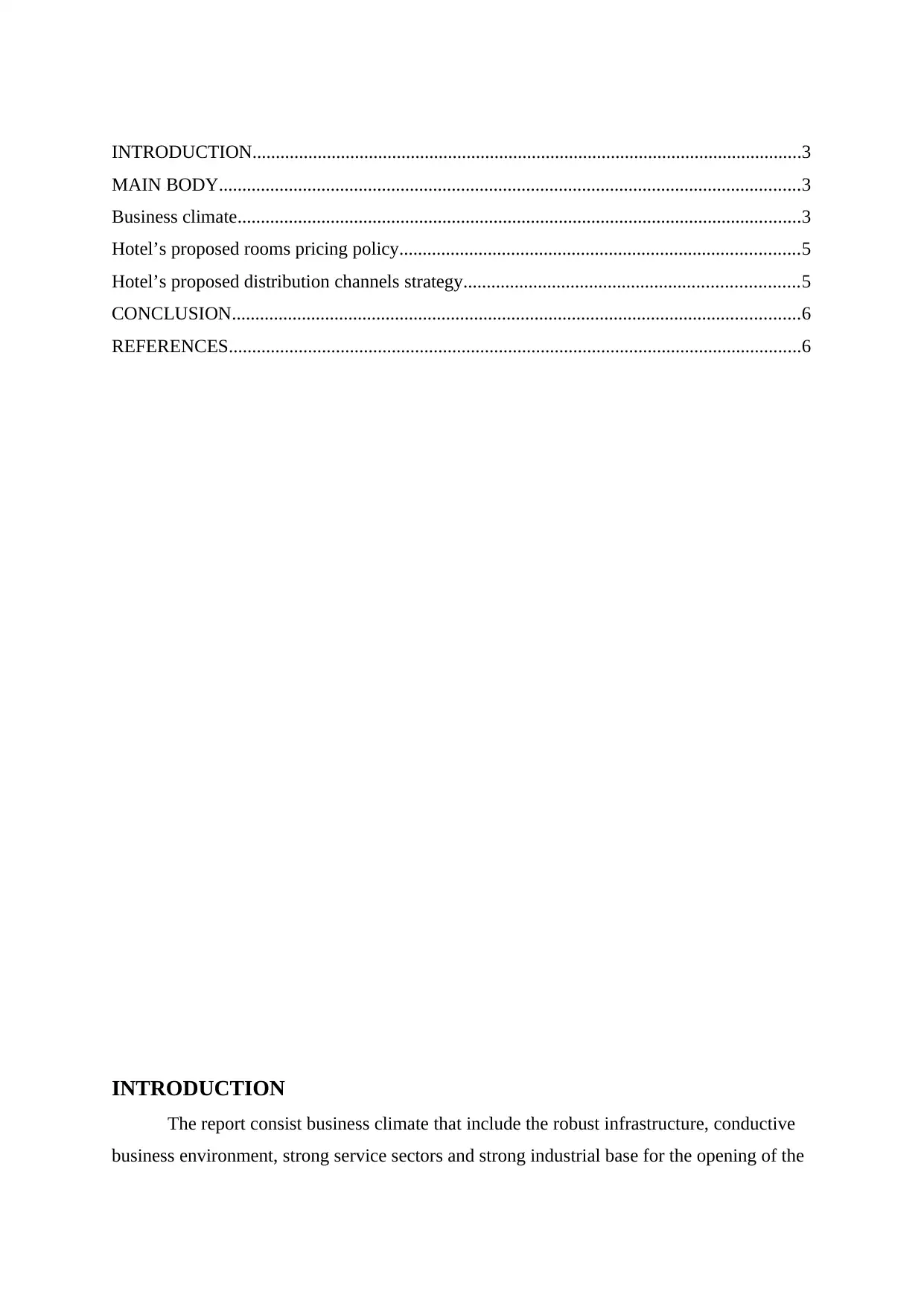
INTRODUCTION......................................................................................................................3
MAIN BODY.............................................................................................................................3
Business climate.........................................................................................................................3
Hotel’s proposed rooms pricing policy......................................................................................5
Hotel’s proposed distribution channels strategy........................................................................5
CONCLUSION..........................................................................................................................6
REFERENCES...........................................................................................................................6
INTRODUCTION
The report consist business climate that include the robust infrastructure, conductive
business environment, strong service sectors and strong industrial base for the opening of the
MAIN BODY.............................................................................................................................3
Business climate.........................................................................................................................3
Hotel’s proposed rooms pricing policy......................................................................................5
Hotel’s proposed distribution channels strategy........................................................................5
CONCLUSION..........................................................................................................................6
REFERENCES...........................................................................................................................6
INTRODUCTION
The report consist business climate that include the robust infrastructure, conductive
business environment, strong service sectors and strong industrial base for the opening of the
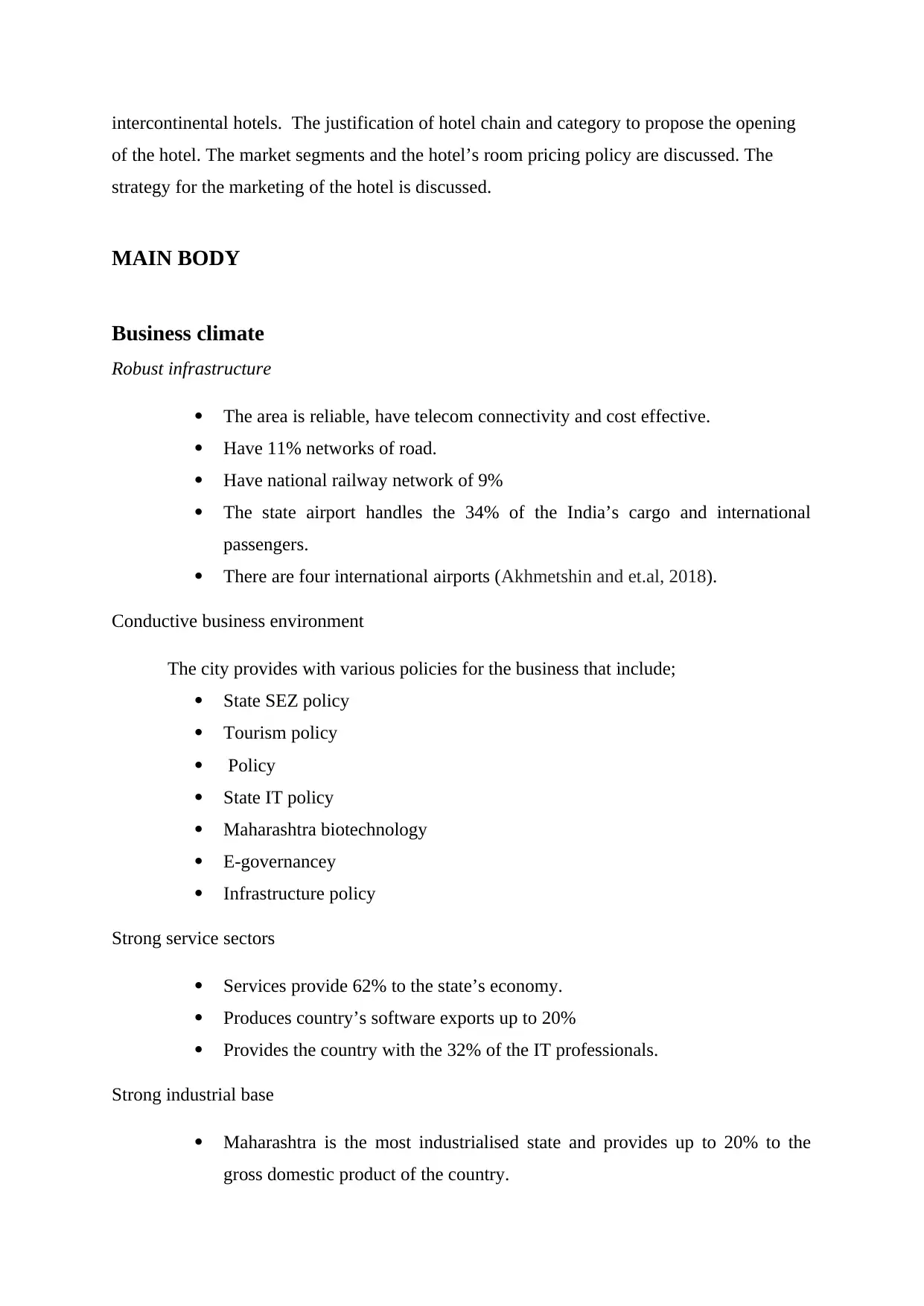
intercontinental hotels. The justification of hotel chain and category to propose the opening
of the hotel. The market segments and the hotel’s room pricing policy are discussed. The
strategy for the marketing of the hotel is discussed.
MAIN BODY
Business climate
Robust infrastructure
The area is reliable, have telecom connectivity and cost effective.
Have 11% networks of road.
Have national railway network of 9%
The state airport handles the 34% of the India’s cargo and international
passengers.
There are four international airports (Akhmetshin and et.al, 2018).
Conductive business environment
The city provides with various policies for the business that include;
State SEZ policy
Tourism policy
Policy
State IT policy
Maharashtra biotechnology
E-governancey
Infrastructure policy
Strong service sectors
Services provide 62% to the state’s economy.
Produces country’s software exports up to 20%
Provides the country with the 32% of the IT professionals.
Strong industrial base
Maharashtra is the most industrialised state and provides up to 20% to the
gross domestic product of the country.
of the hotel. The market segments and the hotel’s room pricing policy are discussed. The
strategy for the marketing of the hotel is discussed.
MAIN BODY
Business climate
Robust infrastructure
The area is reliable, have telecom connectivity and cost effective.
Have 11% networks of road.
Have national railway network of 9%
The state airport handles the 34% of the India’s cargo and international
passengers.
There are four international airports (Akhmetshin and et.al, 2018).
Conductive business environment
The city provides with various policies for the business that include;
State SEZ policy
Tourism policy
Policy
State IT policy
Maharashtra biotechnology
E-governancey
Infrastructure policy
Strong service sectors
Services provide 62% to the state’s economy.
Produces country’s software exports up to 20%
Provides the country with the 32% of the IT professionals.
Strong industrial base
Maharashtra is the most industrialised state and provides up to 20% to the
gross domestic product of the country.
⊘ This is a preview!⊘
Do you want full access?
Subscribe today to unlock all pages.

Trusted by 1+ million students worldwide
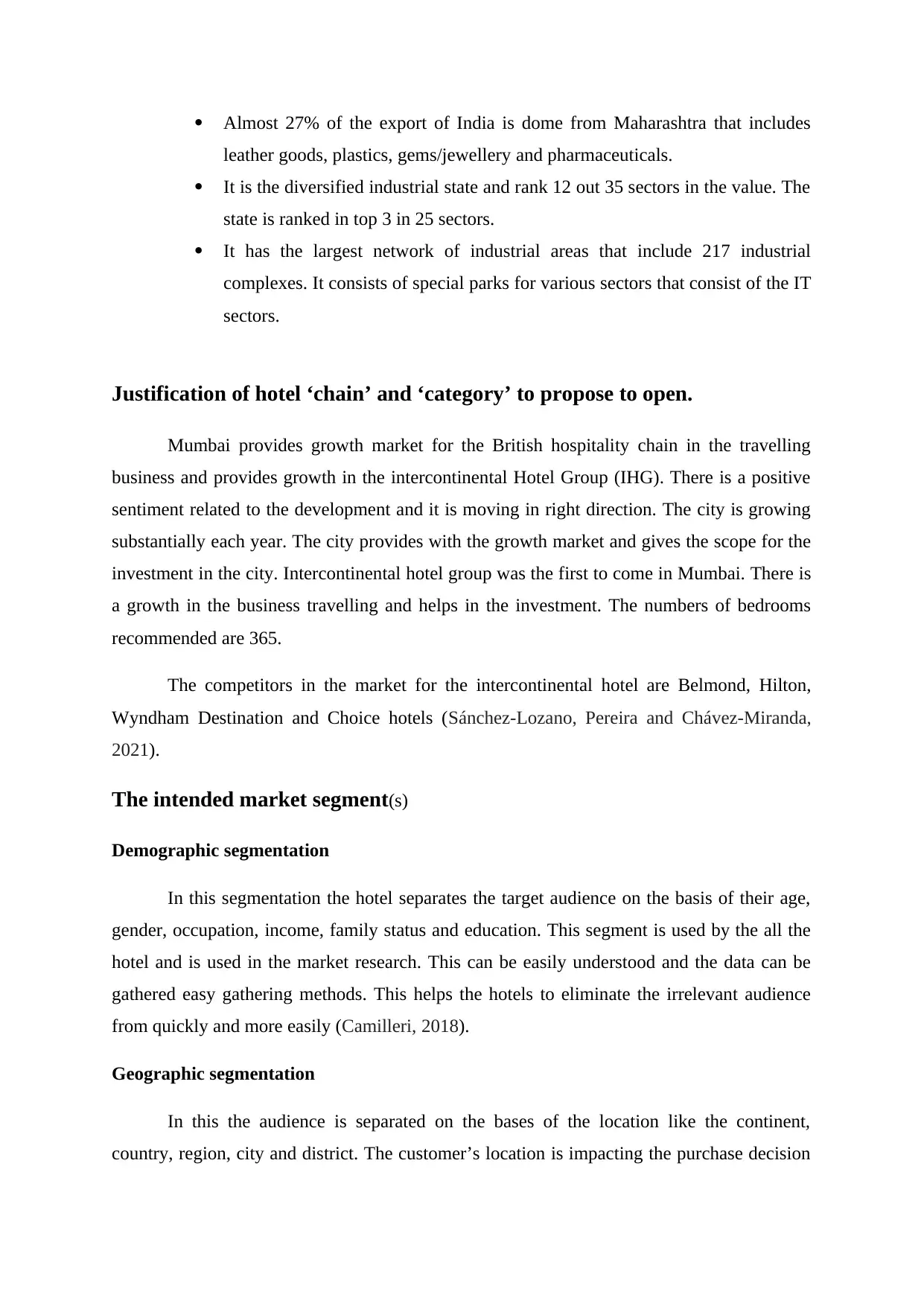
Almost 27% of the export of India is dome from Maharashtra that includes
leather goods, plastics, gems/jewellery and pharmaceuticals.
It is the diversified industrial state and rank 12 out 35 sectors in the value. The
state is ranked in top 3 in 25 sectors.
It has the largest network of industrial areas that include 217 industrial
complexes. It consists of special parks for various sectors that consist of the IT
sectors.
Justification of hotel ‘chain’ and ‘category’ to propose to open.
Mumbai provides growth market for the British hospitality chain in the travelling
business and provides growth in the intercontinental Hotel Group (IHG). There is a positive
sentiment related to the development and it is moving in right direction. The city is growing
substantially each year. The city provides with the growth market and gives the scope for the
investment in the city. Intercontinental hotel group was the first to come in Mumbai. There is
a growth in the business travelling and helps in the investment. The numbers of bedrooms
recommended are 365.
The competitors in the market for the intercontinental hotel are Belmond, Hilton,
Wyndham Destination and Choice hotels (Sánchez-Lozano, Pereira and Chávez-Miranda,
2021).
The intended market segment(s)
Demographic segmentation
In this segmentation the hotel separates the target audience on the basis of their age,
gender, occupation, income, family status and education. This segment is used by the all the
hotel and is used in the market research. This can be easily understood and the data can be
gathered easy gathering methods. This helps the hotels to eliminate the irrelevant audience
from quickly and more easily (Camilleri, 2018).
Geographic segmentation
In this the audience is separated on the bases of the location like the continent,
country, region, city and district. The customer’s location is impacting the purchase decision
leather goods, plastics, gems/jewellery and pharmaceuticals.
It is the diversified industrial state and rank 12 out 35 sectors in the value. The
state is ranked in top 3 in 25 sectors.
It has the largest network of industrial areas that include 217 industrial
complexes. It consists of special parks for various sectors that consist of the IT
sectors.
Justification of hotel ‘chain’ and ‘category’ to propose to open.
Mumbai provides growth market for the British hospitality chain in the travelling
business and provides growth in the intercontinental Hotel Group (IHG). There is a positive
sentiment related to the development and it is moving in right direction. The city is growing
substantially each year. The city provides with the growth market and gives the scope for the
investment in the city. Intercontinental hotel group was the first to come in Mumbai. There is
a growth in the business travelling and helps in the investment. The numbers of bedrooms
recommended are 365.
The competitors in the market for the intercontinental hotel are Belmond, Hilton,
Wyndham Destination and Choice hotels (Sánchez-Lozano, Pereira and Chávez-Miranda,
2021).
The intended market segment(s)
Demographic segmentation
In this segmentation the hotel separates the target audience on the basis of their age,
gender, occupation, income, family status and education. This segment is used by the all the
hotel and is used in the market research. This can be easily understood and the data can be
gathered easy gathering methods. This helps the hotels to eliminate the irrelevant audience
from quickly and more easily (Camilleri, 2018).
Geographic segmentation
In this the audience is separated on the bases of the location like the continent,
country, region, city and district. The customer’s location is impacting the purchase decision
Paraphrase This Document
Need a fresh take? Get an instant paraphrase of this document with our AI Paraphraser
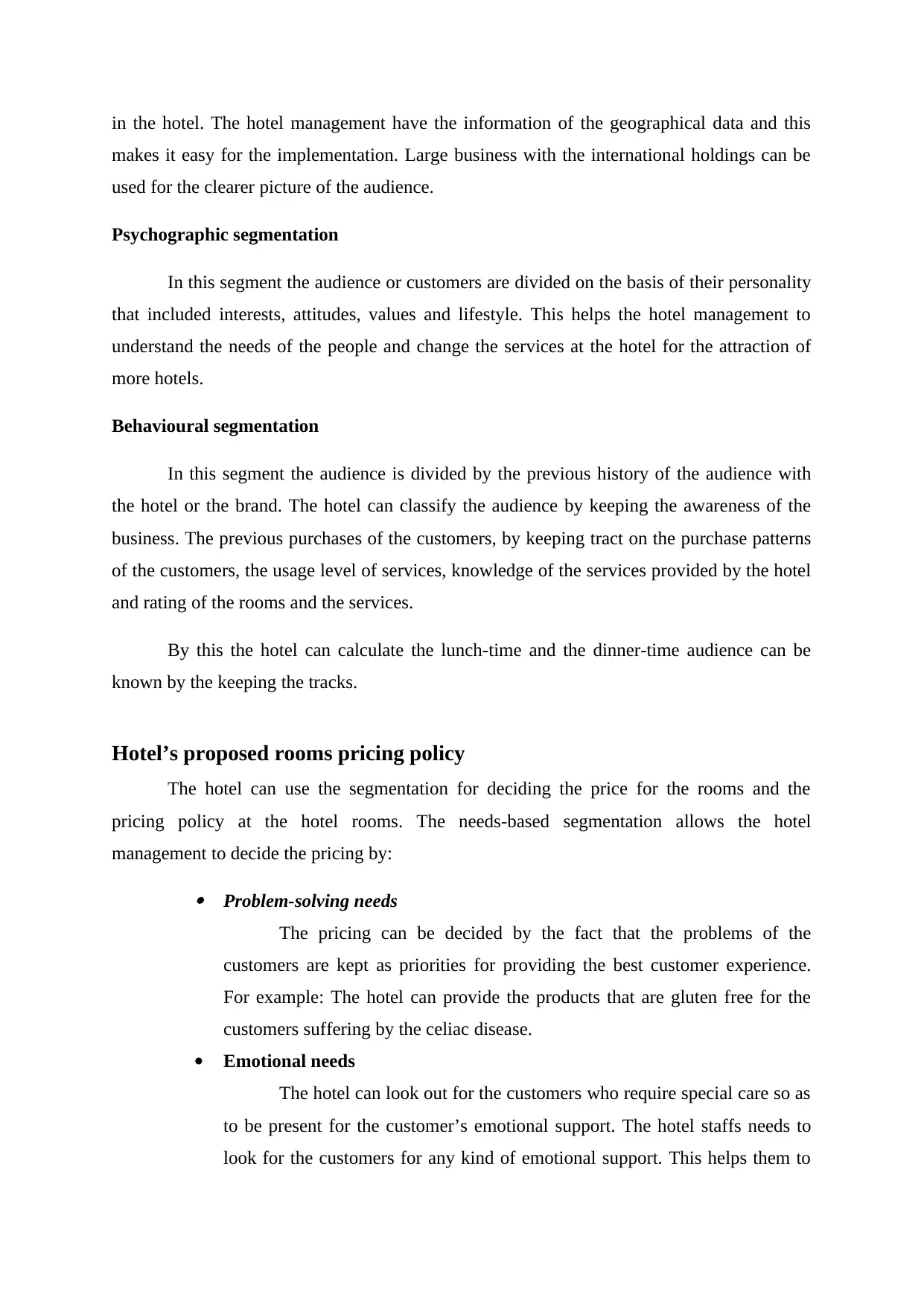
in the hotel. The hotel management have the information of the geographical data and this
makes it easy for the implementation. Large business with the international holdings can be
used for the clearer picture of the audience.
Psychographic segmentation
In this segment the audience or customers are divided on the basis of their personality
that included interests, attitudes, values and lifestyle. This helps the hotel management to
understand the needs of the people and change the services at the hotel for the attraction of
more hotels.
Behavioural segmentation
In this segment the audience is divided by the previous history of the audience with
the hotel or the brand. The hotel can classify the audience by keeping the awareness of the
business. The previous purchases of the customers, by keeping tract on the purchase patterns
of the customers, the usage level of services, knowledge of the services provided by the hotel
and rating of the rooms and the services.
By this the hotel can calculate the lunch-time and the dinner-time audience can be
known by the keeping the tracks.
Hotel’s proposed rooms pricing policy
The hotel can use the segmentation for deciding the price for the rooms and the
pricing policy at the hotel rooms. The needs-based segmentation allows the hotel
management to decide the pricing by: Problem-solving needs
The pricing can be decided by the fact that the problems of the
customers are kept as priorities for providing the best customer experience.
For example: The hotel can provide the products that are gluten free for the
customers suffering by the celiac disease.
Emotional needs
The hotel can look out for the customers who require special care so as
to be present for the customer’s emotional support. The hotel staffs needs to
look for the customers for any kind of emotional support. This helps them to
makes it easy for the implementation. Large business with the international holdings can be
used for the clearer picture of the audience.
Psychographic segmentation
In this segment the audience or customers are divided on the basis of their personality
that included interests, attitudes, values and lifestyle. This helps the hotel management to
understand the needs of the people and change the services at the hotel for the attraction of
more hotels.
Behavioural segmentation
In this segment the audience is divided by the previous history of the audience with
the hotel or the brand. The hotel can classify the audience by keeping the awareness of the
business. The previous purchases of the customers, by keeping tract on the purchase patterns
of the customers, the usage level of services, knowledge of the services provided by the hotel
and rating of the rooms and the services.
By this the hotel can calculate the lunch-time and the dinner-time audience can be
known by the keeping the tracks.
Hotel’s proposed rooms pricing policy
The hotel can use the segmentation for deciding the price for the rooms and the
pricing policy at the hotel rooms. The needs-based segmentation allows the hotel
management to decide the pricing by: Problem-solving needs
The pricing can be decided by the fact that the problems of the
customers are kept as priorities for providing the best customer experience.
For example: The hotel can provide the products that are gluten free for the
customers suffering by the celiac disease.
Emotional needs
The hotel can look out for the customers who require special care so as
to be present for the customer’s emotional support. The hotel staffs needs to
look for the customers for any kind of emotional support. This helps them to
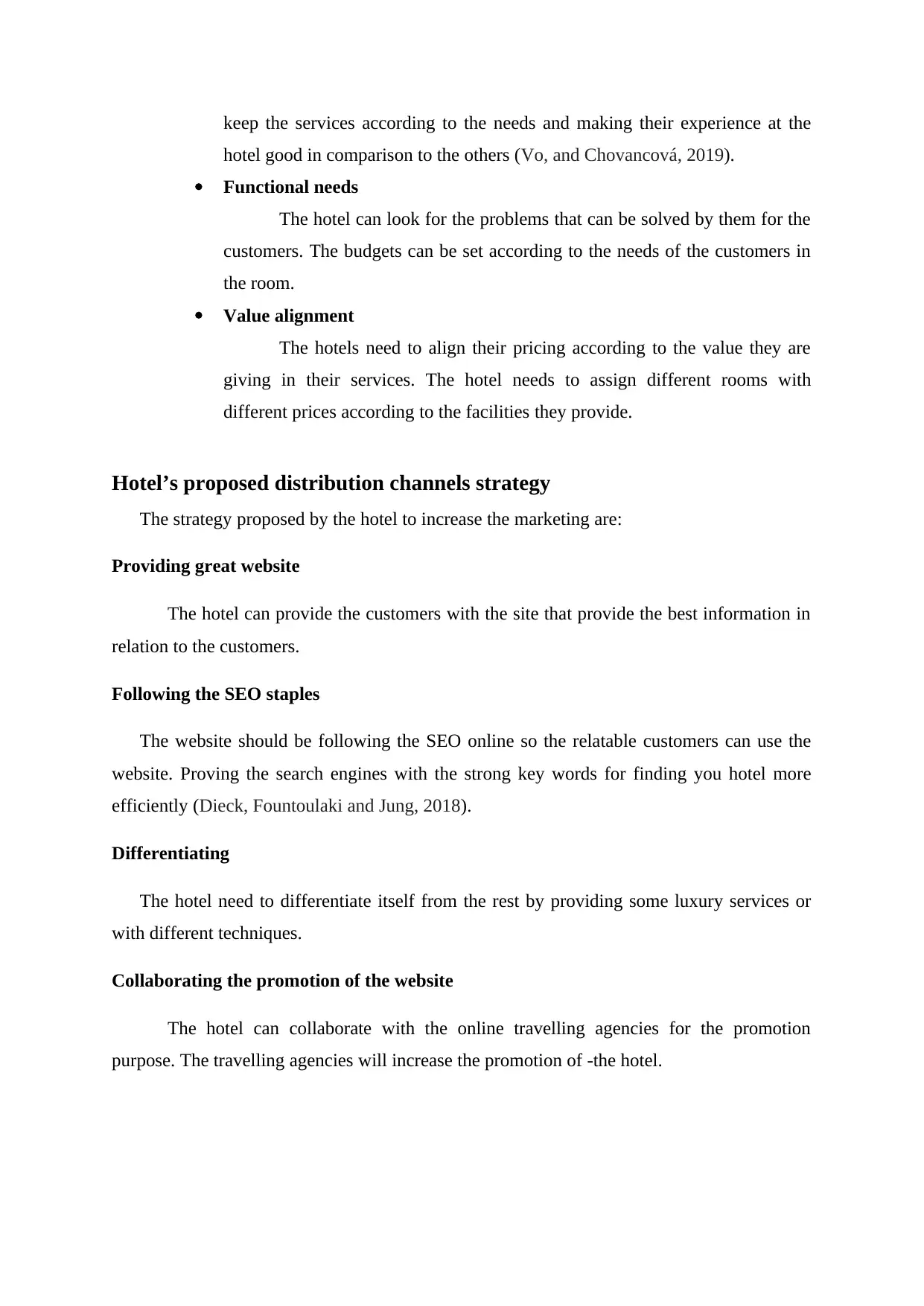
keep the services according to the needs and making their experience at the
hotel good in comparison to the others (Vo, and Chovancová, 2019).
Functional needs
The hotel can look for the problems that can be solved by them for the
customers. The budgets can be set according to the needs of the customers in
the room.
Value alignment
The hotels need to align their pricing according to the value they are
giving in their services. The hotel needs to assign different rooms with
different prices according to the facilities they provide.
Hotel’s proposed distribution channels strategy
The strategy proposed by the hotel to increase the marketing are:
Providing great website
The hotel can provide the customers with the site that provide the best information in
relation to the customers.
Following the SEO staples
The website should be following the SEO online so the relatable customers can use the
website. Proving the search engines with the strong key words for finding you hotel more
efficiently (Dieck, Fountoulaki and Jung, 2018).
Differentiating
The hotel need to differentiate itself from the rest by providing some luxury services or
with different techniques.
Collaborating the promotion of the website
The hotel can collaborate with the online travelling agencies for the promotion
purpose. The travelling agencies will increase the promotion of -the hotel.
hotel good in comparison to the others (Vo, and Chovancová, 2019).
Functional needs
The hotel can look for the problems that can be solved by them for the
customers. The budgets can be set according to the needs of the customers in
the room.
Value alignment
The hotels need to align their pricing according to the value they are
giving in their services. The hotel needs to assign different rooms with
different prices according to the facilities they provide.
Hotel’s proposed distribution channels strategy
The strategy proposed by the hotel to increase the marketing are:
Providing great website
The hotel can provide the customers with the site that provide the best information in
relation to the customers.
Following the SEO staples
The website should be following the SEO online so the relatable customers can use the
website. Proving the search engines with the strong key words for finding you hotel more
efficiently (Dieck, Fountoulaki and Jung, 2018).
Differentiating
The hotel need to differentiate itself from the rest by providing some luxury services or
with different techniques.
Collaborating the promotion of the website
The hotel can collaborate with the online travelling agencies for the promotion
purpose. The travelling agencies will increase the promotion of -the hotel.
⊘ This is a preview!⊘
Do you want full access?
Subscribe today to unlock all pages.

Trusted by 1+ million students worldwide
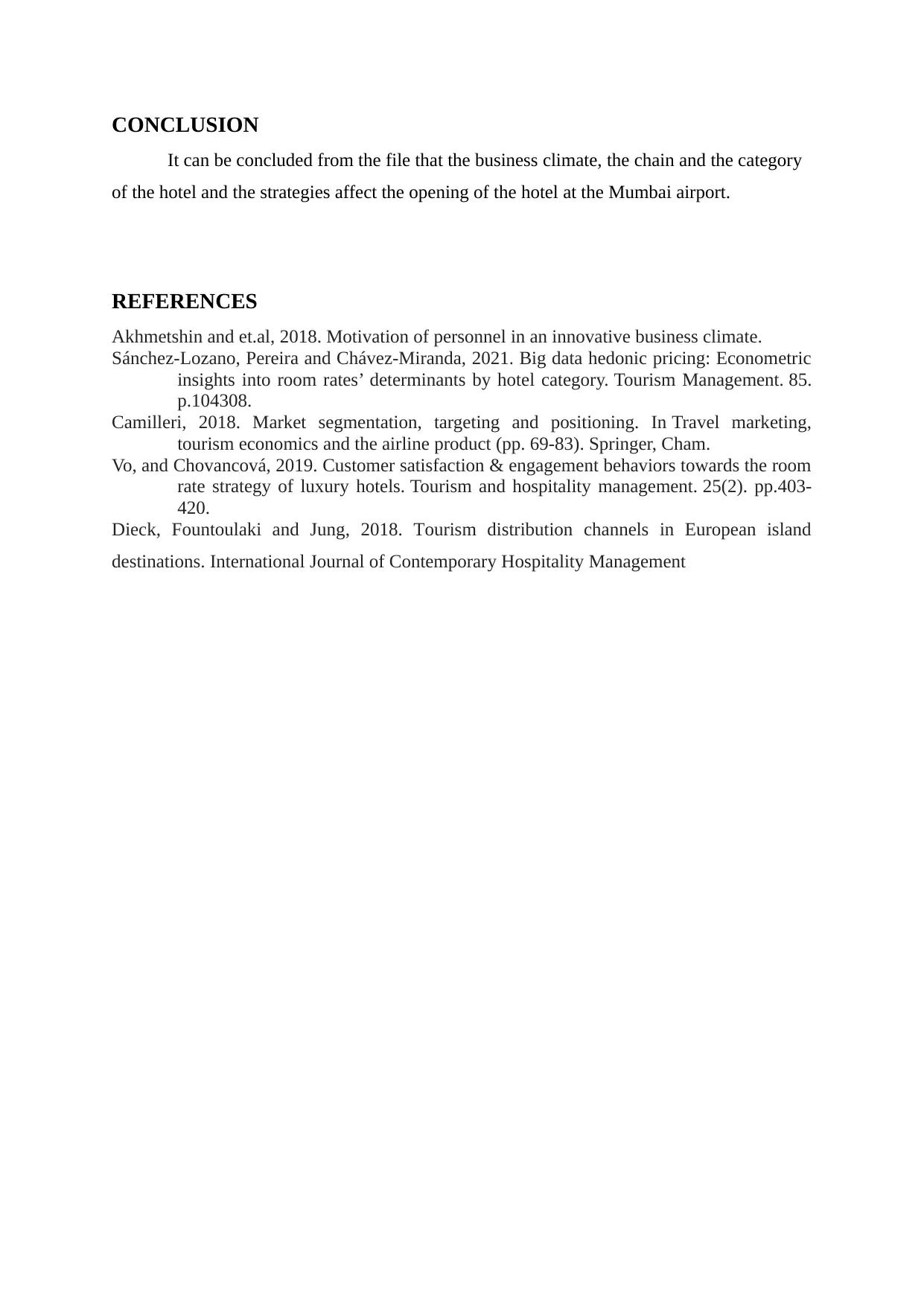
CONCLUSION
It can be concluded from the file that the business climate, the chain and the category
of the hotel and the strategies affect the opening of the hotel at the Mumbai airport.
REFERENCES
Akhmetshin and et.al, 2018. Motivation of personnel in an innovative business climate.
Sánchez-Lozano, Pereira and Chávez-Miranda, 2021. Big data hedonic pricing: Econometric
insights into room rates’ determinants by hotel category. Tourism Management. 85.
p.104308.
Camilleri, 2018. Market segmentation, targeting and positioning. In Travel marketing,
tourism economics and the airline product (pp. 69-83). Springer, Cham.
Vo, and Chovancová, 2019. Customer satisfaction & engagement behaviors towards the room
rate strategy of luxury hotels. Tourism and hospitality management. 25(2). pp.403-
420.
Dieck, Fountoulaki and Jung, 2018. Tourism distribution channels in European island
destinations. International Journal of Contemporary Hospitality Management
It can be concluded from the file that the business climate, the chain and the category
of the hotel and the strategies affect the opening of the hotel at the Mumbai airport.
REFERENCES
Akhmetshin and et.al, 2018. Motivation of personnel in an innovative business climate.
Sánchez-Lozano, Pereira and Chávez-Miranda, 2021. Big data hedonic pricing: Econometric
insights into room rates’ determinants by hotel category. Tourism Management. 85.
p.104308.
Camilleri, 2018. Market segmentation, targeting and positioning. In Travel marketing,
tourism economics and the airline product (pp. 69-83). Springer, Cham.
Vo, and Chovancová, 2019. Customer satisfaction & engagement behaviors towards the room
rate strategy of luxury hotels. Tourism and hospitality management. 25(2). pp.403-
420.
Dieck, Fountoulaki and Jung, 2018. Tourism distribution channels in European island
destinations. International Journal of Contemporary Hospitality Management
1 out of 7
Related Documents
Your All-in-One AI-Powered Toolkit for Academic Success.
+13062052269
info@desklib.com
Available 24*7 on WhatsApp / Email
![[object Object]](/_next/static/media/star-bottom.7253800d.svg)
Unlock your academic potential
Copyright © 2020–2025 A2Z Services. All Rights Reserved. Developed and managed by ZUCOL.





